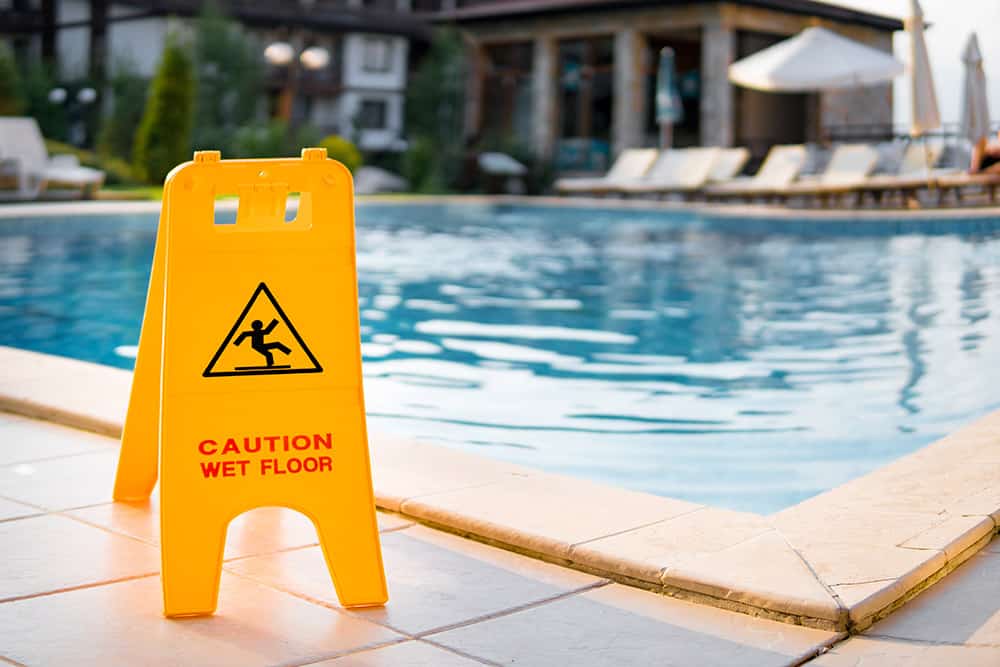What Are Some of the Most Common Swimming Pool Injuries?

There are few better ways to escape the summer heat in Illinois than by going for a swim. Whether you choose to spend your day at a public pool or a friend’s backyard pool, your attempt to cool off could ultimately prove to be dangerous.
You are at risk for much more than just a sunburn when you go swimming. Some of the most common swimming pool injuries can send you or your child to the emergency room. Every year, our slip and fall lawyers see an increase in swimming injuries during the hot summer months. At Prince Law Firm, we want everyone to be safe, so we’ve compiled information on the most common swimming pool injuries and what you can do to limit your risk of being hurt while swimming.
Accidents and Injuries That Occur in Swimming Pools
Emergency rooms treat around 5,400 children under the age of 15 for non-fatal drownings every year. This figure only looks specifically at drowning-related injuries and does not encapsulate the full impact of swimming accidents and injuries. Despite swimming being one of America’s favorite pastimes, it has never been what we might think of as a safe activity.
Swimmers—especially young children—are vulnerable to several different serious swimming injuries. The pool is almost a perfect storm of multiple risk factors, including wet and slippery flooring, large bodies of water, electrical hazards, and hazardous chemicals. Swimmers of all ages are susceptible to the following swimming accidents:
- Drowning. Perhaps the most well-known type of swimming injury, drowning is caused when a swimmer is submerged under water and suffocates. Any death that occurs within 24 hours after being submersed is considered a drowning death. There are many reasons a person might become submersed, including inadequate swimming skills, exhaustion, fatigue, or cramping.
- Entrapment drowning. Pools use filters that suck in water and other debris, filtering out substances and keeping the water clean. The strong suction on these filters can entrap or entangle hair, as can other objects like pool ladders and lane ropes. When any body part becomes trapped or entangled under the water, drowning and even head injuries are possible.
- Near drowning. An incident is considered to be a near drowning if the swimmer survives for 24 hours or longer after being submersed under water. If a person succumbs to their injuries and passes away more than 24 hours later, the death would not be considered a drowning.
- Diving board accidents. Head injuries, broken bones, and even paralysis can occur if you use a diving board that’s been placed near shallow depths. At a minimum, water depth should be between 7.5 and nine feet in inground swimming pools to safely use a diving board. Poorly maintained or malfunctioning diving boards can also cause harm.
- Pool slide accidents. Using a swimming pool slide can lead to injuries ranging from minor to severe. From friction burns on the backs of a swimmer’s thighs to head injuries when the slide drops into shallow water, slides have the potential to cause real harm.
- Entrapment under pool toys and floats. Inflatable pool toys and floats offer a retreat from the water while still allowing swimmers to actively engage with others in the pool. Children and poor swimmers are at risk for becoming trapped underneath these toys, which can lead to serious injury, drowning, or near drowning events.
- Slip and fall accidents. Walkways and flooring around the exterior of the pool and surrounding areas are highly likely to be wet. Even if swimmers do their best to dry off with towels, it is nearly impossible not to track water from the pool. Everyone should exercise caution when walking around pools, even those who are not swimming. Remind everyone to walk instead of run, as a slip and fall accident on a wet surface is dangerous. Victims may suffer head injuries, broken bones, or may even fall into the pool.
- Pool chemical accidents. Pool chemicals send more than 4,500 people to the emergency room every year. The majority of these injuries occur in teens and children. Although injuries can vary, the most common pool chemical injuries diagnosed in the ER are poisoning from breathing in chemical vapors, gases, and fumes. Even opening a chlorine container can be dangerous.
- Electrical injuries. Electrical systems that were installed incorrectly, poorly maintained, or are malfunctioning can leak electrical currents into pools. Electric shock drowning (ESD) is dangerous and can injure or kill swimmers.
The above accidents can happen in the blink of an eye. Public pools should always employ trained lifeguards who rotate positions every 30 minutes. Rotating positions combats both emotional and physical fatigue associated with the job and helps lifeguards be more alert as they watch for signs of distress or danger. Parents and other responsible adults should always supervise any time that children and teens are in backyard or private pools. A watchful eye can help prevent some of the most common swimming pool injuries:
- Traumatic brain injuries
- Spinal cord injuries
- Broken bones
- Paralysis
- Disembowelment or evisceration
- Death
Childhood Drowning Statistics
According to the Centers for Disease Control and Prevention (CDC), drowning is one of the leading causes of death for kids. Drowning causes more deaths for children between the ages of one and four than any other cause, with the exception of birth defects. Annually, there are 3,960 child drownings in the United States and 8,080 non-fatal drownings.
Drownings can occur at even the most unexpected times, including when children are not supposed to be near bodies of water. A significant number of drownings occur when small children slip away from their parents or caregivers and access a pool while unattended.
Public vs. Private Pool Liability
Both public and private pool owners can be held liable for common swimming pool injuries. Few pool owners are eager to take responsibility for any neglect or inaction that caused a serious injury, though. At Prince Law Firm, our attorneys have what it takes to prove fault and liability in swimming injury cases.
If you need compensation for your injuries or are seeking damages after losing a child to a preventable drowning, you are not alone. We can guide you through the process step-by-step, from making the initial claim to gathering and providing evidence that demonstrates fault.
Contact us today to schedule a free case evaluation. Our slip and fall lawyers are ready to speak with you.









